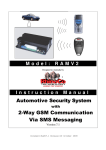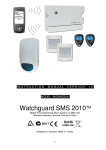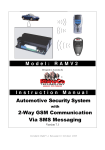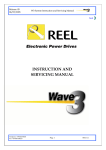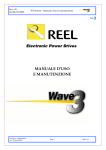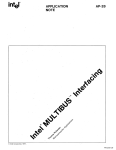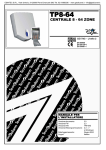Download AVS 9000 Owner`s manual
Transcript
AVS 9000 Owner’s manual Contents Content Pg Programmed numbers reference 4 Introduction 5 The remotes 5 Remote batteries Remote quick reference guide 5 5 About the cellular modem 6 SIM card set-up 6 Mobile phone safety precautions 7 Using the SMS commands 7 Secure operation SMS operation 7 8 Normal operation 8 Arming Disarming Auto-immobilisation Alarm trigger Panic/car finder Status report Low car battery warning If your keys are locked in the car Valet mode 8 9 10 10 11 11 11 11 12 Battery back-up siren 12 Siren keys Siren battery 12 12 Dual stage shock sensor 13 Glass break sensor 13 Secure operation PIN code 13 How to change the PIN code How to change the PIN code when you don’t know the existing code 13 14 2 Content Stored mobile phone numbers Pg To get a list of the stored mobile phone numbers To add or change a mobile phone number To delete a mobile phone number 14 15 15 AVS 9000 system ID 15 To add a remote 16 Programming features 17 To turn programming features on or off Register 1 Register 2 Register 3 17 18 19 21 Optional features 22 Central locking Boot release from the remote Auto re-arm and re-lock Passive arming Door lock on ignition Door lock on alarm trigger Perimeter night light on disarm SMS controlled relay outputs 22 22 22 22 22 22 23 23 Additional sensors and accessories 24 Wireless sensors Standard sensors 24 24 SMS commands glossary 25 SMS commands and replies SMS alerts 26 28 Frequently asked questions 29 Three year warranty 30 14 3 Programmed numbers reference Record the programmed numbers for your future reference: Vehicle ID (eg. registration plate) AVS 9000 SIM card number: This is your AVS 9000‘s cellular modem number AVS 9000 secure operation PIN: Vodafone account PIN: Stored mobile numbers: 1: 2: 3: 4: 5: IMPORTANT Each time the module sends an SMS it is charged at the normal Vodafone network rate. It is your responsibility to have enough money on the SIM card for the module to send SMS. 4 Introduction Thank you for choosing the AVS 9000 SMS security system. This system is designed to provide an advanced level of security for you and your vehicle with the additional security of two-way SMS (text message) communication. We recommend that you read this guide carefully and keep it in a safe place for future reference. The remotes Two remote controls are supplied and are used to control the system functions (in addition to SMS). The remotes have rolling codes (4 billion) to foil code-grabbing devices. Remote batteries Each remote is fitted with CR2025 long life Lithium batteries. Replacement batteries are available from electrical retailers or AVS dealers. Replace the remote batteries if: 1. The remote range begins to decrease. 2. The remote’s LED flashes when a button is pushed. Note: Like any electrical device the remotes contain sensitive components that are easily damaged or broken, especially if dropped or exposed to water. They are expensive to replace so please take care of them. Remote quick reference guide Button Function 1 ARMS alarm and locks doors (if installed) DISARMS alarm and unlocks doors (if installed) DISARMS the immobilisers 2 Press for 3-seconds for boot release (if installed) 3 Hold to activate LED torch 4 Activates PANIC/car finder 1+2 SILENT arm/disarm 5 About the cellular modem The AVS 9000 has an inbuilt cellular modem that allows two-way communication between your mobile phone and the alarm via SMS (text message). The modem operates with a SIM card in the same way as a mobile phone. It runs on a Vodafone pre-pay SIM card. It is your responsibility to ensure your cellular modem SIM card has money on it at all times for two-way SMS communication to operate. The AVS 9000 relies on cellular coverage for SMS communication (the alarm will work regardless of cellular coverage). The system will warn you on arming by remote by chirping three times if there is low cellular coverage. However, if your phone is switched off or outside cellular coverage and there is an alarm trigger you will only receive a notification SMS when your phone is switched back on or is back in range. Note: Manta Electronics and the various network providers do not guarantee the delivery of SMS or calls. Manta Electronics accepts no liability for consequential losses resulting from the non-receipt or delayed receipt of an SMS. Please see the Understanding SMS sheet included for more information. SIM card set-up Do NOT insert or remove the cellular modem SIM card while the power is on. Ensure power is off and the AVS 9000 is unplugged first. If this has not already been done by the installer (or for any reason you remove the SIM card and need to replace it): 1. 2. Place the new SIM card in an existing mobile phone and turn off “PIN code request.” You may need to refer to your mobile phone manual on how to do this. Call 707 and set the 4-digit Vodafone account PIN code. Record the PIN in the Programmed numbers reference in this 6 3. 4. manual. You will need the Vodafone account PIN code when you want to check or top up the cellular modem’s SIM card balance. Insert the SIM card into the AVS 9000’s cellular modem. Save the AVS 9000 cellular modem’s SIM card number in your mobile phone to easily recall for sending SMS commands. We recommend that you save it with a meaningful name i.e. AVS 9000 or other so it is instantly recognisable and you are able to take immediate action if you are contacted by the system. Mobile phone safety precautions Please follow these basic mobile phone safety precautions. 1. 2. 3. Aircraft - Mobile phones can interfere with an aircraft’s navigation system and its mobile network. The use of mobile phones on board aircraft is forbidden by law so please ensure your mobile phone is switched off. Medical equipment - Radio transmitters, including mobile phones can interfere with the operation of inadequately protected medical devices. Please address all questions to a doctor or manufacturer of the medical device. Loss/theft - If your mobile phone and/or your SIM card are lost or stolen, notify your network operator immediately in order to avoid misuse. Note: Under no circumstances shall Manta Electronics be responsible for any loss of data or income or any special, incidental, consequential or indirect damages howsoever caused. Using the SMS commands Secure operation You must enter a 6-digit PIN code at the start of each SMS command. The default PIN code is 000000 (all zeros). Please change this to a number that you will remember and record it in the Programmed Numbers Reference. See SMS Secure Operation PIN code for more information. 7 SMS operation Sending an SMS to the alarm From a mobile phone type the secure operation PIN code followed by the command. Example: 000000COMMAND Tips • You must put the secure operation PIN code at the start of each command • The message is not case sensitive • Do not use spaces • The reply SMS will be sent back to the same phone the command SMS was sent from Receiving an SMS from the alarm • • • The AVS 9000 will reply to any command SMS sent to it It will reply to the same phone the command came from The AVS 9000 will identify itself at the start of each SMS. To change this see AVS 9000 system identification (ID). Normal operation Arming By SMS 1. 2. 3. 4. 5. 6. Type your PIN code and ARM (or A) Example: 000000ARM or 000000A The indicators will flash once and the siren will chirp once. The doors will lock (if optional central locking installed). The LED light on the dash will light solid for 20 seconds. The LED light will then start flashing. The system is now armed. You will receive a SMS reply with the alarm state: Example: ALARM ARMED 8 By remote 1. 2. 3. 4. 5. Press the bottom button. The indicators will flash once and the siren will chirp once. The doors will lock (if optional central locking installed). The LED light on the dash will light solid for 20 seconds. The LED light will then start flashing. The system is now armed. Note: If you take longer than 38 seconds to leave the car after turning off the ignition when you press the bottom button it will DISARM not arm the system. Press it again to arm. The indicators will flash once and the siren will chirp once to confirm the system has armed. See Auto immobilisation for more information. Door ajar warning • • • If the siren chirps and the indicators flash for three seconds on arming a door is open. If you armed via SMS the SMS reply will include a warning Example: ALARM ARMED. DOOR AJAR WARNING The system will exclude that zone until it is properly closed. Silent arm To silently arm press the bottom and left button of the remote together. Disarming By SMS 1. 2. 3. 4. 5. Type your PIN code and DISARM (or D) Example: 000000DISARM or 000000D The indicators will flash and the siren will chirp twice. The doors will unlock (if optional central locking installed). The LED light on the dash will go out. The system is now disarmed. You will receive a SMS reply with the alarm state: Example: ALARM DISARMED 9 By remote 1. 2. 3. 4. Press the bottom button. The indicators will flash and the siren will chirp twice. The doors will unlock (if optional central locking installed). The LED light on the dash will go out. The system is now disarmed. Note: If the siren chirps and the indicators flash four times on disarm the alarm has been triggered while you were away from the vehicle. Auto-immobilisation The system will immobilise 38 seconds after the ignition is turned off. The LED light on the dash will light solid to show it is in autoimmobilise mode. The system must be disarmed before the car can be started. Follow the disarming instructions. Alarm trigger If door, bonnet or boot is opened, or the glass break sensor or shock sensor is triggered, while the alarm is armed the siren will sound and the indicators will flash for 30 seconds. The system will then re-set itself. SMS trigger notification When the alarm is triggered an SMS will also be sent to all the programmed mobile phone numbers (up to five). The SMS will tell you what has triggered the alarm. Example: ALARM ACTIVATED. GLASS. The alarm will also call the number programmed into Location 1 if there is no response to an alarm trigger by either remote or SMS. This feature can be programmed off by your installer. See page 21. Note: If the alarm is triggered three times by the same zone (example: shock sensor) the alarm will bypass that zone until the next time you arm the system. This helps reduce false alarms caused by faulty sensors or switches. 10 Panic/car finder 1. 2. 3. 4. 5. Ensure the car ignition is off. Press the right button on the remote. The indicators will flash and the siren will sound. An SMS will be sent to all the programmed mobile phone numbers (up to five): Example: PANIC ALERT! Cancel panic by pushing the right button again. Status report The status report SMS lists the alarm state, phone signal strength and car battery level. 1. 2. Type your PIN code and STATUS Example: 000000STATUS You will receive a SMS reply with the alarm state: Example: ALARM ARMED. PHONE SIGNAL GOOD. CAR BATTERY GOOD. Low car battery warning The alarm will send an SMS to all the programmed mobile phone numbers (up to five) if your car battery’s voltage reaches a critical level. This message will only be sent once in a low battery condition. Example: BATTERY LOW WARNING If your keys are locked in the car If your keys are locked in the car simply arm the alarm then disarm it by SMS. The doors will unlock (if central locking is installed) allowing you in to the vehicle. 11 Valet mode This mode allows five engine starts before the system returns to its normal operation. Example: if you take the vehicle to valet parking and you normally use auto-immobilisation they will be able to star the car five times before auto immobilisation re-engages. Turn valet mode on 1. 2. 3. 4. 5. Disarm the alarm. Open the driver’s door. Turn the ignition on. Push the bottom button on the remote six times. Turn the ignition off. Battery back-up siren The siren has its own battery and charging system so it will continue to sound if power is cut to it from the car. Siren keys The siren is supplied with two keys that fit the switch on the top of the siren. If disconnecting your vehicle’s battery turn off the siren first (or the siren will sound). Remember to turn it back on after the battery is reconnected! Note: Turning the siren off does NOT turn off the alarm. Siren battery The siren battery charges off your car’s battery automatically. If the car battery goes flat the siren will sound. In this instance turn off the siren with your key and recharge the car’s battery. Once this is done remember to turn the siren back on. If the siren battery is flat it will re-charge itself after approximately one hour. 12 Dual stage shock sensor If the shock sensor detects a light impact to the vehicle the siren will chirp four times. If it detects a heavy impact it will trigger a full alarm. The sensor can tell the difference between environmental shocks (aircraft, trucks, extreme weather) and other heavy impacts such as a thief attempting to break in. This reduces false triggers. The sensor will sample the background noise when the alarm is armed and adjust itself accordingly. This also reduces false triggers. Glass break sensor If this sensor detects the sound frequency of breaking glass it triggers the alarm. To help reduce false triggers the shock sensor also needs to pick up a vibration to the vehicle. Secure operation PIN code You must enter a 6-digit PIN code at the start of each SMS command. The default PIN code is 000000. Please change this to a number that you will remember and record it in the Programmed Numbers Reference. How to change the PIN code 1. 2. Type your existing PIN code and then PIN and then the new PIN code Example: 000000PINXXXXXX (where 000000 is the existing PIN code and XXXXXXX is the new PIN code) You will receive a SMS reply confirming the new PIN code: Example: NEWPINXXXXXX 13 How to change the PIN code when you don’t know the existing code If you have lost or forgotten your PIN code you can change it to a new number as long as you have the alarm remote/s. 1. 2. 3. Type NEWPIN code and then the new PIN code Example: NEWPINXXXXXX (where XXXXXXX is the new PIN code) The siren will chirp and the indicators will flash nine times. Before it stops press the bottom button on the remote. You will receive a SMS reply confirming the new PIN code: Example: NEWPINXXXXXX Note: If you do not press the bottom button on the remote in time you will receive a SMS stating PIN CODE FAIL. Start again at 1. Tips for setting the PIN code 1. 2. 3. The PIN code must be 6 digits long It can consist of any combination of the numbers 0-9 and letters A-Z. The PIN code is NOT case sensitive Example: xxxxxx is the same as XXXXXX Stored mobile phone numbers The AVS 9000 can store up to five mobile numbers so that: • On alarm trigger an SMS will be sent to all stored numbers • The alarm can ring the number in Location 1 if there is no response to a trigger SMS • On panic an SMS will be sent to all stored numbers • An SMS will be sent to all stored numbers if the car battery is going flat Note: You will be charged the standard Vodafone SMS rate for each SMS sent from the AVS 9000. Example: if you have five stored numbers the system will send five SMS. Please see the Understanding SMS sheet enclosed. 14 To get a list of the stored mobile phone numbers 1. 2. Type your PIN code and READPHONE Example: 000000READPHONE You will receive a SMS reply listing all the stored numbers and their memory location: Example: 1. 02X XXX XXX, 2: NOT USED, 3: 02X XXX XXX, 4: 02X XXX XXX, 5: NOT USED To add or change a mobile phone number 1. 2. 3. To add a number you need to specify the memory location and mobile phone number Type your PIN code and WRITEPHONE then the location (15) then the mobile phone number Example: 000000WRITEPHONE2XXXXXXXXX (where 2 is the memory location and XXXXXXXXXX is the number) You will receive a SMS reply listing all the stored numbers and their location: Example: 1. NOT USED, 2: 02X XXX XXX, 3: 02X XXX XXX, 4: 02X XXX XXX, 5: NOT USED Note: The AVS 9000 will overwrite any existing number stored in the memory location you specify. To delete a mobile phone number 1. 2. 3. To delete a number you need to specify the memory location the number is stored in Type your PIN code and ERASEPHONE then the location (15) Example: 000000ERASEPHONE1 (where 1 is the memory location) You will receive a SMS reply listing all the stored numbers and their location: Example: 1. NOT USED, 2: 02X XXX XXX, 3: 02X XXX XXX, 4: 02X XXX XXX, 5: 02X XXX XXX 15 AVS 9000 system ID There is a system ID at the start of each SMS you receive from the AVS 9000. This can be changed. 1. 2. Type your PIN code and ID and then the new ID Example: 000000IDXXXX (where XXXX is the new ID) You will receive a SMS reply confirming the new ID: Example: XXXX ID CHANGE PASSED (where XXXX is the new ID) Tips: • The ID can be up to 19 digits long • It can consist of any combination of the numbers 0-9 and letters A-Z • The ID is NOT case sensitive (xxxxxx is the same as XXXXXX) To add a remote By SMS 1. 2. 3. 4. 5. Make sure the alarm is disarmed and the ignition is off. Type your PIN code and LEARN Example: 000000LEARN You will receive a SMS reply stating the alarm is ready: Example: LEARN MODE ACTIVATED SUCCESSFULLY Within 15 secs the siren will begin to chirp and the indicators flash. As this happens press and hold the bottom button on the new remote until the chirping and flashing stops. The new remote is now coded in. Test it by arming/disarming the system with the new remote. By remote 1. 2. 3. 4. Disarm the alarm. Enter the vehicle and ensure the doors/bonnet/boot are shut. Turn on the ignition. Immediately press and hold the bottom button on the original remote until the siren starts chirping and the indicators flash (approximately four seconds) and then release the button. 16 5. 6. 7. Immediately press and hold the bottom button on the new remote for at least four seconds. Turn the ignition off. The new remote is now coded in. Test it by arming/disarming the system with the new remote. Notes: • If you wish to code in more than one remote repeat the process for each new remote • If you need to delete a remote please see your AVS dealer Programming features Programming features are set up by your AVS installer during installation. We recommend consulting your installer before attempting to change the programming features as damage to your vehicle or the alarm may occur. To turn programming features on or off 1. 2. 3. 4. 5. Find the programming register (1-3) for that feature. (Example: passive arming is located in register 1). Set the vehicle up as described for that register. (Example: for register 1 close all doors/bonnet/boot then turn ignition on). Press the bottom button on the remote the number of times indicated for that feature. (Example: 4 x shock sensor). Turn the ignition off. The system will then chirp in order the number of times for each feature that is turned on. (Example: it will miss the shock sensor code of four chirps because that feature has just been disabled). Tips: 1. The alarm must be disarmed prior to making programming changes. 2. If your vehicle has interior light delay wait until the light fades out before turning the ignition on in step 2. 3. Feature 9 is excluded from the confirmation chirps on all registers. 17 Register 1 Vehicle set up: Close all doors/bonnet/boot THEN turn the ignition on. (Remote* = press bottom button on remote this many times) Feature Arming chirp Disarm chirp Auxiliary sensor Shock sensor Remote* Factory Description 1 2 ON ON 3 ON 1 chirp on arm. 2 chirps on disarm. Activate any additional sensors fitted. Activate shock sensor. System arms automatically 60 seconds after exit. The doors will not lock. If disarmed and a door not opened within 60 seconds, the alarm will re-arm and re-lock. Sends a door lock pulse on alarm trigger. This can help frustrate a thief’s attempt to enter the vehicle (a thief picks the door lock which triggers the alarm and the doors immediately re-lock). 4 ON Passive arming 5 OFF Auto rearm/re-lock 6 OFF Door lock pulse on alarm trigger 7 OFF Not used 8 OFF Shock sensor adjustment 9 6 SELECT the level required. Press remote 9 times to enter mode then turn ignition to OFF. There are 8 levels of adjustment (factory setting 6). Pressing the remote once will increase the sensitivity by 1 level i.e. to 7. The LED will flash 7 times to confirm level 7. Pressing the remote again will increase the sensitivity to level 8 (max). Pressing the remote again will return the adjustment to level 1 (least sensitive). Once the level is set, turn the ignition ON to exit this mode. 18 Register 2 Vehicle set up: Driver’s door open, bonnet/boot closed THEN turn the ignition on. (Remote* = press bottom button on remote this many times) Feature Remote* Factory Not used Not used No auto immobilisation OEM upgrade for factory remote operation 1 2 3 OFF OFF OFF 4 OFF Silent operation 5 OFF Valet mode 6 OFF Central closure 7 OFF Not used 8 Description Removes autoimmobilisation. Allows the vehicles factory remotes to be used to operate the alarm. Also requires the OEM Enhancement module. When ON, this feature stops the siren from sounding. The alarm will still trigger and send SMS. When ON, this feature allows 5 engine starts before the system returns to its normal operation i.e. if you normally use passive arming, you will be able to start the car five times before passive arming re-engages. When ON, the lock and unlock outputs become a 15-sec negative pulse instead of 0.5 secs. Use for vehicles with vacuum central locking or with a central closure wire (some BMW, Mercedes) i.e. doors lock, electric windows wind up, sunroof closes automatically. Continued overleaf 19 Feature Installer mode Remote* Factory 9 SELECT the mode required Register 2 continued Description This mode allows the installer/owner to verify that each trigger of the alarm system is working, without having to arm and disarm the system each time and set off the siren. After pressing the remote 9 times to enter this mode, turn the ignition to OFF. The siren will chirp and the indicators will flash to indicate a trigger eg. push the bonnet switch, open a door, hit the vehicle. The siren will chirp four times to indicate a pre-warning impact sensor detection, or once to indicate full alarm trigger level. Turn the ignition to ON to exit this mode. 20 Register 3 Vehicle set up: Driver’s door open, bonnet open, boot closed THEN turn the ignition on. (Remote* = press bottom button on remote this many times) Feature Remote* Call if no response 1 Factory ON Door lock on ignition 2 OFF Two second exit delay 3 OFF No door ajar warning 4 OFF Passive arming from ignition off 5 OFF Perimeter night light 6 OFF Instant boot release 7 OFF External pre-warn output 8 OFF Description Call phone number in memory location 1 if there was no response to an alarm trigger. When ON, the doors will lock when the ignition is turned ON, and un-lock when the ignition is turned OFF. When ON, the normal 20-sec exit delay is reduced to 2-secs i.e. the alarm is fully armed 2secs after pressing the remote. When ON, the door ajar warning feature is removed (the siren and indicators will not beep and flash for 3-seconds if a door is not closed properly). When ON, the system arms automatically 60-seconds the ignition is turned off. The doors will not lock. When ON, the indicators will stay on constantly for 20seconds on disarm, or until the ignition is turned ON. When ON, the boot release button (left) can be pressed once only rather than held down for three secs to open an electric boot. When ON, the internal alarm pre-warn is disabled and a 2-sec output from the boot wire is given. 21 Optional features Optional features are dependent on the systems already in your vehicle. Some features may require additional parts and/or additional installation charges. Not all features are available on all vehicles and they are subject to change. Please check with your AVS installer. Central locking The alarm can lock/unlock the doors when the alarm is armed/disarmed. Boot release from the remote 1. 2. 3. Make sure the vehicle ignition is turned off. Press the left button on the remote for three seconds. The boot will unlock (and if the system is armed it will disarm). Auto re-arm and re-lock This feature prevents the accidental disarming of the system. It will re-arm and (if central locking connected) re-lock the doors if the system is disarmed and a door not opened within 60 seconds. Passive arming This feature will automatically arm the alarm 60 seconds after the ignition is turned off. It does not lock the doors. Door lock on ignition The system will lock the doors with the ignition is turned on, and unlock them when the ignition is turned off (if central locking is connected). Door lock on alarm trigger The system will send a door lock pulse on alarm trigger. This can help frustrate a thief’s attempt to enter the vehicle (a thief picks the door lock which triggers the alarm and the doors immediately re-lock). 22 Perimeter night light on disarm The indicators will stay on for 20-seconds when the alarm is disarmed or until the ignition is switched on (not available if auto rearm and re-lock is turned on). SMS controlled relay outputs The system has three outputs that can be switched on and off by SMS. These can be used to control functions such as turning your car lights on/off or to operate other devices such as extra sirens or window roll-up modules. To operate an SMS relay output To turn output 1 on: 1. Type your PIN code and ONOUT1 Example: 000000ONOUT1 2. The system will turn on that function Example: your car lights will turn on 3. You will receive a SMS reply: Example: OUTPUT1 TURNED ON To turn output 1 off: 1. Type your PIN code and OFFOUT1 Example: 000000OFFOUT1 2. The system will turn off that function Example: your car lights will turn off 3. You will receive a SMS reply: Example: OUTPUT1 TURNED OFF Note: To turn output 2 and 3 on and off simply change the output number on the SMS Example: ONOUT2, OFFOUT2, ONOUT3, OFFOUT3 Tips: • The output will stay on until you turn it off via SMS • The function cannot be operated by remote 23 Test all three outputs 1. 2. 3. Type your PIN code and TEST Example: 000000TEST The system will turn on all three outputs You will receive a SMS reply Additional sensors and accessories The AVS 9000 can be fitted with additional sensors and accessories. Charges will apply. Please check with your AVS installer. Wireless sensors Wireless PIR sensor An infrared sensor that detects body heat and movement they are designed to protect large spaces such as the back of vans or trucks. Wireless reed switch A wireless door switch designed to protect areas such as ute canopies. Standard sensors Glass break sensor Detects the sound frequency of breaking glass. Ultrasonic sensor Measures air pressure and movement within the vehicle and will trigger if the pressure changes. Gives superior protection for the interior of the vehicle. Microwave sensor Ideal for convertibles it detects body mass, such as a person, entering the vehicle. 24 Digital tilt sensor Essential protection for mag wheels. Will trigger if the car is tilted in any direction from 1 degree. Screamer siren An extremely high-pitched screamer siren installed in the cabin of the car. SMS commands glossary Use this guide as a reference for all AVS SMS commands and replies: Tips • • • • • • • • • • • • You must put the secure operation PIN code at the start of each command The message is not case sensitive Do not use spaces The reply SMS will be sent back to the same phone the command SMS was sent from The system is limited to sending a maximum of 25 SMS replies in 8.5 minutes in case of malfunction The default secure operation PIN code is 000000 (all zeros) SMS commands sent with no valid secure operation PIN code will not get responded to If the alarm receives an SMS that contains a valid secure operation PIN code but a command that is not recognised it will reply with a list of commands that are available i.e. UNKNOWN COMMAND. COMMANDS ARE: ARM DISARM PANIC ONOUT1 OFFOUT1 READPHONE WRITEPHONE ERASEPHONE ID PIN Boot and bonnet are identical i.e. history and normal alarm conditions will be known as bonnet for both. There is no voltage drop. The 6-digit secure operation PIN code MUST be in front of all SMS commands. The ID (identification) is at the start of every SMS received from the alarm. 25 SMS commands and replies Each command below is listed with the symbol > referring to SMS commands to send to the system and the symbol < referring to reply SMS from the AVS 9000. > ARM or A (i.e. 000000ARM or 000000A for short) < ALARM ARMED or < ALARM ARMED. DOOR AJAR WARNING! - other trigger responses include BOOT WARNING!, BONNET WARNING!, AUX WARNING! or < ALARM ALREADY ARMED or < ALARM UNABLE TO ARM. IGNITION ON! > DISARM or D < ALARM DISARMED or < ALARM ALREADY DISARMED > PANIC < PANIC ALERT! NOTE: The AVS 9000 will not send PANIC ALERT! when the ignition is on. > ONOUT1 - SMS are the same for outputs 1, 2 and 3. Only the output number changes. < OUTPUT1 TURNED ON > OFFOUT1 - SMS are the same for outputs 1, 2 and 3. Only the output number changes. < OUTPUT1 TURNED OFF > READPHONE – lists all stored mobile phone numbers (up to five) and their location. Location 1 is the mobile number that the system will call if there is no response via SMS or remote to an alarm condition within one minute. < PHONE NUMBERS. 1:XXXX 2:XXXXX 3:XXXXX 4:XXXX 5:XXXXX 26 > ERASEPHONEX – erases the mobile phone number stored at location X (locations 1-5) in the system’s memory. System puts NOT USED for that location in reply SMS eg. ERASEPHONE3 (erase location 3 mobile phone number). < PHONE NUMBERS. 1: XXXXX 2: XXXX 3: NOT USED 4: XXXX 5:XXXX > WRITEPHONEYXXXX – stores the mobile phone number XXXX in location Y (locations 1-5) in the system’s memory eg. WRITEPHONE3021555333. < PHONE NUMBERS 1: XXXX 2: XXXX 3: 021555333 4: XXXX 5: XXXX or < FAILED TO UPDATE PHONE NUMBER, MEMORY LOCATION ERROR - if location 0,6,7,8,9 was entered as the location in error. > IDXXXX – changes the ID that the AVS 9000 sends at the front of all SMS. < XXXX ID CHANGE PASSED. eg > IDXBU-458 < XBU-458. ID CHANGE PASSED. To change your secure operation PIN code if you have forgotten the code: > NEWPINXXXXXX (confirmation then required by pressing the bottom remote button within the time it takes the siren to chirp and the indicators to flash nine times). < NEW PIN NUMBER XXXXXX – the system will confirm the new PIN or < REMOTE CONFIRMATION NOT RECEIVED – no confirmation received < PIN CHANGE FAIL – a valid PIN was not given. Check PIN and re-send - valid characters are numbers 0-9 and letters a-Z (not case sensitive). PIN must be 6-digits long. To change your secure operation PIN code if you know the code: > XXXXXXPINYYYYYY (where XXXXXX is the existing PIN and YYYYYYY the new PIN code) 27 < NEW PIN NUMBER YYYYYY – the system will confirm the new PIN or < PIN CHANGE FAIL – a valid PIN was not given. Check PIN and re-send - valid characters are numbers 0-9 and letters a-Z (not case sensitive). PIN must be 6-digits long. > HISTORY – the system records the last ten alarm triggers. < ALARM HISTORY. OLDEST. XXXXX. XXXXX. XXXX. XXXX. LATEST > STATUS < ALARM ARMED. PHONE SIGNAL XXXX. CAR BATTERY XXX – the system will state whether the phone signal is good or bad and the car battery is good or low. Or < ALARM DISARMED. PHONE SIGNAL XXXX. CAR BATTERY XXX – the system will state whether the phone signal is good or bad and the car battery is good or low. Or < ALARM ACTIVATED. PHONE SIGNAL XXXX. CAR BATTERY XXX – the system will state whether the phone signal is good or bad and the car battery is good or low. > LEARN < LEARN MODE ACTIVATED SUCCESSFULLY. < UNABLE TO ACTIVATE LEARN MODE IGNITION ON. < UNABLE TO ACTIVATE LEARN MODE SYSTEM ARMED. > GSMOFF < PHONE POWER OFF - this will turn the cellular modem off (so no SMS will be sent or received) until an arm/disarm event occurs. SMS alerts The alarm will send an SMS to each of the mobile phone numbers in the system’s memory (up to five) if any of the following occurs: < PANIC ALERT! < ALARM ACTIVATED! XXXX – where XXXX is either bonnet, shock, ignition, door, auxiliary or glass < BATTERY LOW WARNING! 28 Frequently asked questions I am not receiving any SMS from the AVS 9000? Check that the cellular modem SIM card has money on it. Why is the remote range getting shorter? The remote battery is going flat. Replacement batteries are available from your AVS dealer or electrical retailer (CR2025 x 2 per remote). I have lost/damaged my remote. How do I start the car? You can disarm the system using SMS. Replacement remotes can be purchased from your AVS dealer and any lost remotes programmed out of the system. My alarm chirps for three seconds when I arm the system instead of the usual one chirp? The system is warning you that a door is open. Disarm the system, correct the problem and start again. I get four chirps/indicator flashes when I disarm the alarm instead of the usual two chirp/indicator flashes? The system has been triggered. Text 000000HISTORY for a list of recent triggers. I disarmed the system a few minutes ago but now it is armed again? It is most likely that auto re-arm and re-lock has been activated. It can be turned off by your AVS dealer. The system disarms and the dash lights are working but the car won‘t start? There is a clicking sound when I try to start the car? The siren chirps when I crank the engine? This is often an indicator of a flat car battery. The AVS 9000 draws such a small amount of power the system can be armed and disarmed (just like you can still see the dash lights) but the car does not have enough power to start. You will need to replace or recharge the car battery. NOTE: If jump-starting the car to recharge the car battery please use protected jumper leads as failure to do so can do irreparable damage to the alarm system and your car’s computer system and will void your car alarm warranty. I’m worried the alarm will drain the car battery? The AVS 9000 has been designed to draw as small amount of current from your car battery as possible. As long as the car’s battery is in good condition the system should not adversely affect most car’s batteries if left unattended for up to about three weeks. 29 Three year warranty Complete the information below and keep with your original receipt for the three year warranty period. Installation detail: Install date: Installer: NZSA #: Product: Additional: Your details: Surname: Initials: Address: Vehicle make/model: Rego #: Terms and Conditions: Manta Electronics Ltd warrants the original consumer purchaser that the product described above, installed in the vehicle above, is free from defects in material and workmanship. Should this product be proven to be defective in materials or workmanship during the term of the warranty, Manta Electronics Ltd shall replace or repair any product or part of the product which Manta Electronics Ltd agrees is defective, without charge. Warranty on installation labour, removal and reinstallation charges are not the responsibility of Manta Electronics Ltd. If you require a mobile technician to call there will be a call out charge regardless of the cause of the fault. Any damage to the products as a result of misuse, abuse, neglect, accident, incorrect wiring, improper installation, repair or alteration outside Manta Electronics Ltd approved dealers will void warranty. Remote control transmitters and batteries are not covered under warranty. This warranty shall not apply to any product which is found to have been modified, repaired or altered in any way without the express written consent of Manta Electronics Ltd. This warranty shall not apply to any equipment or product connected to the Manta Electronics Ltd product. This warranty does not constitute a guarantee or insurance against the theft of the vehicle or contents thereof. This warranty does not affect your rights under the Consumer Guarantees Act. 30 PO Box 302 396 North Harbour North Shore 0751 New Zealand 00 64 9 476 8052 www.avs.net.nz AVS and the AVS logo are registered trademarks of Manta Electronics Ltd 31
































